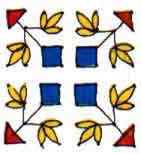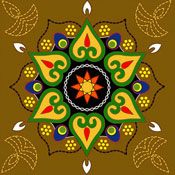 rangoli may also have come from "rang" (color) + "aavalli" (row), which means row of colors, or from rang+avalli, which means creepers of colors. Basically, Rangoli is the art of drawing images and motifs on the floor and walls of one's home using different color powders. Designed with a beautiful combination of various colors, the Rangoli images create an enchanting piece of art. Basically a floor painting, a rangoli image stands for a sign of welcome. The main purpose of making rangolis in diwali is to welcome Goddess Laxmi, the Goddess of wealth, to individual homes apart from warding off the evil eye. The art of rangoli is known by different names in different regions such as "Rangoli" in Maharashtra, Alpana (in Bengal), and Kolam (in South India). Although Rangoli has its origins in Maharashtra, today it is practiced everywhere. One of the most popular arts among Indian women, rangoli is an age old custom of India, and practiced all over the country.
rangoli may also have come from "rang" (color) + "aavalli" (row), which means row of colors, or from rang+avalli, which means creepers of colors. Basically, Rangoli is the art of drawing images and motifs on the floor and walls of one's home using different color powders. Designed with a beautiful combination of various colors, the Rangoli images create an enchanting piece of art. Basically a floor painting, a rangoli image stands for a sign of welcome. The main purpose of making rangolis in diwali is to welcome Goddess Laxmi, the Goddess of wealth, to individual homes apart from warding off the evil eye. The art of rangoli is known by different names in different regions such as "Rangoli" in Maharashtra, Alpana (in Bengal), and Kolam (in South India). Although Rangoli has its origins in Maharashtra, today it is practiced everywhere. One of the most popular arts among Indian women, rangoli is an age old custom of India, and practiced all over the country.The Rangoli designs are passed down through generations, with some of them being hundreds of years old. Though the designs vary in different sections of India, the basic approach is common. The designs are geometric and proportioned. It has been a tradition in culturally rich India to draw Rangoli on the festivals and other auspicious occasions as it is considered a holy ritual. There is a unique relationship between the festival of diwali and rangoli. Diwali is a major festival of India and drawing rangoli on diwali is a part of diwali celebrations.
The patterns are made with finger using rice powder, crushed lime stone, or colored chalk. They may be topped with grains, pulses, beads, or flowers. Since the entire objective of making rangoli in diwali is to welcome Goddess Laxmi, small footprints coming into the home, representing the footprints of the Goddess,
 are also made. Rangolis can be of any size, from the size of a doormat, to the covering an entire room. Though making of a Rangoli is highly dependent on the preferences and skills of the maker, lines are always drawn on one finger movement (rangolis are always drawn with fingers) and frequently, the mapping of the rangoli is done with the help of dots, which are joined to form a pattern, and then the pattern is filled with colors. One important point is that the entire pattern must be an unbroken line, with no gaps to be left anywhere, for evil spirits are believed to enter through such gaps, if they find one. In an expert hand, the images created are elaborate and look as if they are painted. In India, this art is temporary. Each rangoli design generally stays for only a day or two as it is often redone as a part of the daily routine. Certain designs are created on special occasions such as weddings and religious festivals like Diwali.
are also made. Rangolis can be of any size, from the size of a doormat, to the covering an entire room. Though making of a Rangoli is highly dependent on the preferences and skills of the maker, lines are always drawn on one finger movement (rangolis are always drawn with fingers) and frequently, the mapping of the rangoli is done with the help of dots, which are joined to form a pattern, and then the pattern is filled with colors. One important point is that the entire pattern must be an unbroken line, with no gaps to be left anywhere, for evil spirits are believed to enter through such gaps, if they find one. In an expert hand, the images created are elaborate and look as if they are painted. In India, this art is temporary. Each rangoli design generally stays for only a day or two as it is often redone as a part of the daily routine. Certain designs are created on special occasions such as weddings and religious festivals like Diwali.Rangoli Decoration Themes
 Rangoli designs are generally based on themes that have been in use through ages. The common rangoli themes are the celestial symbols such as the rising sun, moon, stars, zodiac signs, holy symbols like Om, mangal kalash, swastika, chakra, a lighted Deepak, trident, "shree", lotus etc. Goddess Lakshmi in the lotus symbolizes the figure of renewed life. Other popular themes are natural images like flowers, creepers, trees, fish, birds, elephants, dancing figures, human figures and geometrical figures such as circles, semi-circles, triangles, squares and rectangles. Drawing Diwali rangoli at the entrance door of individual homes is the common sight during Diwali decoration. For this, the footsteps of Goddess Lakshmi entering into the home are designed at the main entrance of the home or near the place of worship, which indicates the entrance of prosperity in the home. This is the special Diwali rangoli for the entrance. It is considered auspicious as it signifies showering of good luck and prosperity on the house and in the family.
Rangoli designs are generally based on themes that have been in use through ages. The common rangoli themes are the celestial symbols such as the rising sun, moon, stars, zodiac signs, holy symbols like Om, mangal kalash, swastika, chakra, a lighted Deepak, trident, "shree", lotus etc. Goddess Lakshmi in the lotus symbolizes the figure of renewed life. Other popular themes are natural images like flowers, creepers, trees, fish, birds, elephants, dancing figures, human figures and geometrical figures such as circles, semi-circles, triangles, squares and rectangles. Drawing Diwali rangoli at the entrance door of individual homes is the common sight during Diwali decoration. For this, the footsteps of Goddess Lakshmi entering into the home are designed at the main entrance of the home or near the place of worship, which indicates the entrance of prosperity in the home. This is the special Diwali rangoli for the entrance. It is considered auspicious as it signifies showering of good luck and prosperity on the house and in the family.Courtesy by:
http://www.theholidayspot.com/diwali/rangoli.htm
| Some Rangoli Decoration | ||
 |  |  |
No comments:
Post a Comment